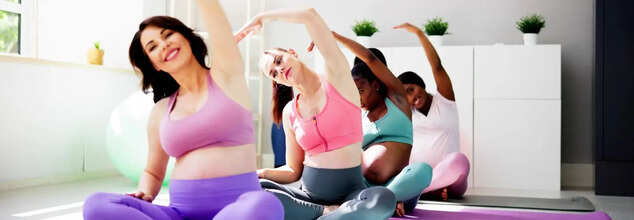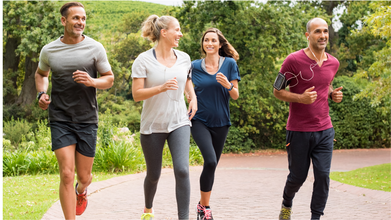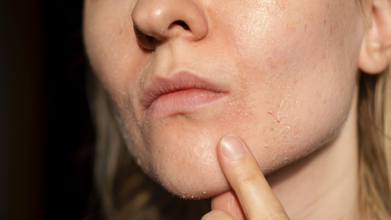- Health Conditions A-Z
- Health & Wellness
- Nutrition
- Fitness
- Health News
- Ayurveda
- Videos
- Medicine A-Z
- Parenting
1 Out Of 6 US Adults Practices Yoga: Why Yoga Is Great For All

Yoga (Credit: Canva)
Nearly 1 in every 6 American adults has practiced yoga in the past year, data from the US government shows. Statistics revealed that yoga remains more popular amongst women (23.3% participation) as compared to men (10.3%). It's also more popular among the young (ages 18 to 44), with 21.3% in that age group saying they practiced yoga, than the middle-aged (14.1%) or those aged 65 or older (8%).
The practice was also influenced with the socio-economic status of people. Overall, 23% of people in the highest income bracket said they practiced yoga versus 10.4% of those at the lowest income level.
Why Are Americans Practicing Yoga?
Yoga is the oldest form of exercise and traces its roots back to ancient India. The word "yoga" comes from the Sanskrit word "yuj," which means "to yoke" or "to bind." Interestingly, yoga incorporates physical postures (asanas), breathing techniques (pranayama), and meditation together. While spirituality lists various benefits of yoga, scientific research into it is still at preliminary stage. However, numerous studies have indicated that it has a significant positive impact on a person's physical and mental health.
This form of exercise is highly popular amongst western countries, particularly the US. When questioned by the researchers, about 80% of yoga practitioners cited "restoring overall health" as the key reason behind practicing yoga. This was especially true for people aged between 45 to 64 years of age.
Meditation Paired With Yoga
In fact, meditation was often being performed with yoga. Nearly, 57% of all practitioners said they meditated as a part of their yoga practice. Interestingly, lower-income people were more likely to engage in meditation and yoga together compared to better-off folks. Another reason cited by them was pain relief. About 29% said that they engaged in yoga to help people treat or manage pain. Again, lower-income people who engaged in yoga were more likely to say that they used the practice to ease pain compared to higher-income people.
Science Based Reasons To Incorporate Yoga Into Your Daily Routine
Firstly, yoga involves stretching muscles, which helps improve flexibility and balance. Moreover, it can also significantly lower stress levels through physical practice, meditation, breath work, and sound rituals, providing relaxation and an improved quality of life. Yoga is recognized as an effective treatment for depression, with research indicating that both movement and breath-based therapies can significantly alleviate depressive symptoms.Certain styles of yoga are strength-building, targeting both upper and lower limbs. Yoga asana can serve as an alternative treatment for anxiety, and practices like Yoga Nidra (a body-scan meditation) have been shown to reduce anxiety symptoms. Research had shown that this form of exercise, improves the quality of life for individuals with chronic pain, enhancing well-being and providing long-term health benefits, particularly for those with persistent health issues.
Yoga helps strengthen the immune system by reducing inflammation and enhancing cell-mediated immunity, especially with consistent practice over time. Pranayama (yogic breathing) has been shown to improve cardiovascular function. Research suggests that controlled breathing may positively affect the heart, brain, and lungs. In addition, it promotes better sleep by helping individuals fall asleep faster and sleep more deeply.
Ray J In Hospital With Pneumonia And Heart Pain: How Common Are These Complications?

Credits: PEOPLE/Canva
Singer and actor Ray J has reportedly been admitted to a hospital in Las Vegas after experiencing what were described as “heart pains,” according to TMZ. The 44-year-old was hospitalized on January 6, with sources telling the outlet that the episode was connected to a severe case of pneumonia. As of Thursday afternoon local time, Ray J was still receiving medical care, TMZ reported.
According to the report, doctors conducted multiple tests, including chest X-rays and an echocardiogram, an ultrasound that checks how well the heart is functioning. The findings from these tests have not been shared publicly. Neither Ray J nor his representatives have released an official statement addressing his health or confirming his current condition.
Although the initial concern focused on possible heart-related issues, TMZ noted that pneumonia appears to be the primary cause behind his hospitalization. It is still unclear whether Ray J remains admitted or has since been discharged.
Ray J Hospitalised With Pneumonia, Heart Pain
This is not the first time Ray J has dealt with a serious pneumonia-related health scare. In late 2021, he was hospitalized after doctors initially suspected COVID-19 before later confirming pneumonia.
At the time, Ray J described the ordeal as life-threatening. “I thought it was over,” he told TMZ while recovering. “I started praying and knew God is good, so I just kept praying.” He later made a full recovery and was discharged after receiving oxygen support.
Despite reports of his recent hospitalization, Ray J has remained active online. He recently posted on Instagram to promote an upcoming event in Austin, Texas, scheduled for January 18 as part of his birthday celebrations. The post made no reference to any health concerns.
Pneumonia: What Is This Disease?
Pneumonia is an infection of the lungs that causes inflammation in the air sacs, known as alveoli. These air sacs may fill with fluid or pus, making breathing difficult and reducing the amount of oxygen reaching the bloodstream. The illness can be caused by bacteria, viruses, or fungi and often presents with symptoms such as coughing, fever, chills, and shortness of breath.
While pneumonia is usually treatable with medication, it can become severe in certain cases, particularly among older adults, young children, and people with weakened immune systems. Because of these risks, pneumonia remains a leading cause of hospitalization, according to the Cleveland Clinic.
Does Pneumonia Come With Heart Symptoms?
Yes. Pneumonia can trigger heart-related symptoms and complications. According to Healthline, patients may experience a rapid heart rate, chest pain, or increased strain on the heart. In more serious cases, pneumonia can worsen existing heart conditions or lead to complications such as arrhythmias, heart failure, or even heart attacks.
The intense inflammation caused by a lung infection places added stress on the cardiovascular system, making early diagnosis and treatment especially important, particularly for older adults or those with underlying heart disease.
How Common Are Pneumonia And Heart Symptoms?
Pneumonia is a common illness and is frequently linked to heart complications. Research cited by the National Institutes of Health shows that roughly one in four hospitalized adults with pneumonia develop major cardiac issues, including heart attacks, heart failure, or abnormal heart rhythms. These complications significantly increase the risk of death.
Heart disease also raises the likelihood of developing pneumonia, creating a two-way relationship between the two conditions. Inflammation from the infection can put additional pressure on the heart, especially in older patients and those with pre-existing cardiovascular problems.
Is Pneumonia With Heart Symptoms Fatal?
Yes, pneumonia accompanied by heart-related symptoms can be fatal. Cardiac complications are common and greatly increase mortality risk, particularly among older adults and individuals with existing heart conditions such as heart failure. The danger is highest in the period immediately following the infection.
Pneumonia places heavy stress on the heart and can trigger heart attacks, strokes, or a rapid worsening of existing heart disease, underscoring the importance of prompt medical care.
- Increased Mortality: Heart complications can make pneumonia more severe and raise the risk of death.
- Triggers Cardiac Events: Infection-related inflammation can lead to heart attacks, strokes, or irregular heart rhythms, even in people without prior heart disease.
- Exacerbates Existing Conditions: For those with heart failure or cardiovascular disease, pneumonia can cause sudden deterioration, leading to respiratory failure and death.
Working Out For 10 Minutes May Decrease Your Risk Of Colorectal Cancer, Study Proves

Credit: Canva
Performing short and intense exercises that last for about 10 minutes may significantly reduce the risk of colorectal cancer, a British study shows.
Researchers at Newcastle University have found that completing brief workouts increases the concentration of several small molecules in the blood that have previously been linked to reducing inflammation, improving blood vessel function and metabolism.
The findings, which were published in the International Journal of Cancer, also noted that even short bouts of exercise can influence the activity of genes that govern tumor growth and fight against cancer.
Dr Sam Orange, Senior Lecturer in Clinical Exercise Physiology at Newcastle University and lead study author, said of the results, "What’s remarkable is that exercise doesn’t just benefit healthy tissues, it sends powerful signals through the bloodstream that can directly influence thousands of genes in cancer cells.
“It’s an exciting insight because it opens the door to find ways that mimic or augment the biological effects of exercise, potentially improving cancer treatment and, crucially, patient outcomes.
“In the future, these insights could lead to new therapies that imitate the beneficial effects of exercise on how cells repair damaged DNA and use fuel for energy.”
How Does It Work?
The study involved 30 participants, both male and female between the ages of 50–78. All of the participants were overweight or obese (a risk factor of cancer) but otherwise healthy.Researchers had asked each volunteer to complete a short, intense cycling test that lasted about 10 minutes and collected each of their blood samples which were then meticulously analyzed.
After studying about 249 proteins, the experts found nearly 13 protein had increased in their blood flow after the short exercise including interleukin-6 (IL-6), which helps repair the DNA of damaged cells.
When these exercise-induced proteins were applied to colorectal or bowel cancer cells by the scientists in a lab, they discovered that these new proteins could alter the activity of over 1,300 genes, particularly those who were responsible for DNA repair, energy production and cancer cell growth.
As a result, they concluded that performing even small exercises can activate a set of genes in the body's cells that can support efficient use of oxygen and promote energy metabolism. Additionally, the British researchers also discovered that the cell genes which have been previously associated with rapid cell growth were switched off after working out, suggesting that this might aid in controlling cancerous growths in the body.
What Is Colorectal Cancer?
Colorectal or bowel cancer is a common cancer that forms in the tissues of the colon (large intestine) or rectum, often starting as non-cancerous growths called polyps that turn cancerous over time.
Despite being treatable and preventable, colorectal cancer is currently the second leading cause of cancer-related deaths worldwide. Over 70,000 new cases of colorectal cancer occur annually in India, making it the fourth most common cancer in the country.
Typical symptoms usually include :
- Blood in or on the stool
- Changes in bowel habits (diarrhea, constipation, narrower stools)
- Abdominal discomfort, cramps, gas, or pain
- Feeling that your bowel doesn't empty completely
- Weakness, fatigue, or unexplained weight loss
Expert Explains: Why Do Allergies And Rashes Increase In Winter? According To Dermatologist

Credits: iStock
When temperature drops, so does the moisture even in your skin. This is what leads to a rash or allergies. In fact, with changes in temperature, and winters, our lifestyle changes too, this could also be the reason why we experience a winter rash, or allergies. To understand this better, Health and Me spoke to Dr Navjot Arora, Consultant Dermatologist, Dermaheal Skin and Clinic at Dwarka, Delhi, who explained that allergies and skin rashes tend to increase during winter due to both, environmental factors and changes in skin health. "Cold temperatures and low humidity levels reduce moisture in the air, leading to excessive dryness of the skin. When the skin becomes dry, its natural protective barrier weakens. This makes it more prone to irritation, inflammation, and allergic reactions."
Why Does Winter Weather Increase Chances Of Rashes And Allergies?
The doctor explains that during winter, people tend to stay indoors more, and it also increases their exposure to allergens like dust mites, mold, pet dander, and chemical fumes from heaters and cleaning products. "Limited ventilation and closed spaces allow these allergens to build up, triggering allergic responses and skin rashes, especially in individuals with sensitive skin or pre-existing conditions like eczema."
Cold weather also affects blood circulation to the skin. Reduced blood flow can slow down the skin’s repair process and weaken its defense against irritants and allergens. As a result, chronic skin conditions such as eczema, psoriasis, and contact dermatitis often worsen in winter, leading to itching, redness, flaking, and rashes.
Lifestyle Changes In Winter
Doctor also points out that during winters, our bathing habit changes. Dr Arora says, "Frequent hot showers strip away the skin’s natural oils, increasing dryness and irritation. In addition, wearing heavy woolen or synthetic clothing can cause friction, sweating, and contact allergies, particularly in skin folds, which can further contribute to rashes."
Common Symptoms Of Winter Rashes
- flushing
- swelling
- itching
- flaking skin
- sensitivity
- bumps
- blisters
If not treated well, or in time, it can develop into more serious health threat, especially if you have a family history of
- eczema or another type of dermatitis
- psoriasis
- rosacea
- allergies
- asthma
- sensitive skin
What Are The Cures To Winter Rashes And Allergies?
The rise in allergies and rashes during winter is largely linked to dry weather, indoor allergen exposure, and skin barrier damage. Maintaining proper skin hydration, avoiding harsh soaps, limiting hot water exposure, and wearing skin-friendly fabrics can help reduce the risk of winter-related allergies and skin rashes.
Moisturizers are usually the first line of care for dry skin because they help trap moisture and prevent further dryness. Apply them multiple times a day, especially after bathing or washing your hands. Thicker options like creams or ointments tend to keep skin hydrated longer than lighter lotions.
Petroleum jelly can also be effective, as it forms a protective barrier that seals in moisture. If you prefer to avoid petroleum-based products, alternatives like Waxelene or Un-Petroleum work in a similar way to reduce moisture loss.
Natural virgin oils, such as coconut oil, may help calm irritated skin and restore hydration. Use them on areas that are not acne-prone, and always do a patch test on a small area for 24 hours before wider application.
Oatmeal-based soaps or oatmeal baths can also help soothe dry, itchy skin. You can buy ready-made oatmeal soaps or add finely ground oats to a warm bath and soak for about 10 minutes.
For itching and inflammation, topical hydrocortisone creams, available over the counter or by prescription, may provide relief. Always follow the instructions on the label or use them as advised by a doctor.
Disclaimer: This is not a substitute for actual prescribed medicine. Please consult a doctor before you purchase any medicine or ointment for your rashes.
© 2024 Bennett, Coleman & Company Limited

